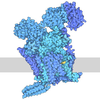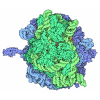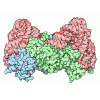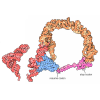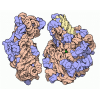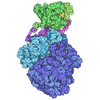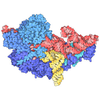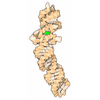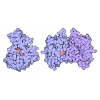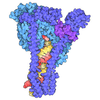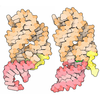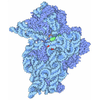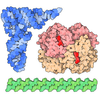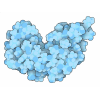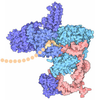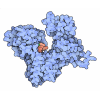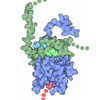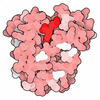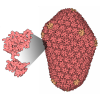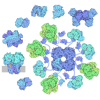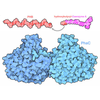+ データを開く
データを開く
- 基本情報
基本情報
| 登録情報 | データベース: PDB / ID: 9ndp | ||||||
|---|---|---|---|---|---|---|---|
| タイトル | Structure of stalled ribosome and nascent chain in complex with NMT2 and NAC | ||||||
 要素 要素 |
| ||||||
 キーワード キーワード | RIBOSOME / protein synthesis / N-glycine myristoylation / NMT2 / NAC | ||||||
| 機能・相同性 |  機能・相同性情報 機能・相同性情報postsynaptic cytoskeleton / Acetylcholine regulates insulin secretion / epithelial cell maturation involved in salivary gland development / organelle / positive regulation of vascular wound healing / ATF6-mediated unfolded protein response / positive regulation of protein acetylation / negative regulation of protein localization to endoplasmic reticulum / nascent polypeptide-associated complex / outer dense fiber ...postsynaptic cytoskeleton / Acetylcholine regulates insulin secretion / epithelial cell maturation involved in salivary gland development / organelle / positive regulation of vascular wound healing / ATF6-mediated unfolded protein response / positive regulation of protein acetylation / negative regulation of protein localization to endoplasmic reticulum / nascent polypeptide-associated complex / outer dense fiber / negative regulation of striated muscle cell apoptotic process / regulation of skeletal muscle fiber development / intracellular transport of virus / positive regulation of cell proliferation involved in heart morphogenesis / response to insulin-like growth factor stimulus / N-terminal peptidyl-glycine N-myristoylation / peptidyl-lysine N6-myristoyltransferase activity / positive regulation of skeletal muscle tissue growth / glandular epithelial cell maturation / positive regulation of lactation / sterol homeostasis / IRE1alpha activates chaperones / ATF6 (ATF6-alpha) activates chaperone genes / positive regulation of plasma cell differentiation / regulation of opsin-mediated signaling pathway / positive regulation of phospholipid biosynthetic process / cardiac ventricle development / negative regulation of myotube differentiation / positive regulation of ERAD pathway / intracellular triglyceride homeostasis / actin crosslink formation / ventricular cardiac muscle tissue development / bleb / glycylpeptide N-tetradecanoyltransferase / glycylpeptide N-tetradecanoyltransferase activity / cellular response to fructose stimulus / chromatoid body / cellular response to laminar fluid shear stress / regulation of modification of postsynaptic actin cytoskeleton / XBP1(S) activates chaperone genes / positive regulation of dendritic spine morphogenesis / heart trabecula morphogenesis / cellular response to nutrient / skeletal muscle tissue regeneration / dendritic branch / positive regulation of hepatocyte proliferation / cellular response to fluid shear stress / positive regulation of MHC class II biosynthetic process / negative regulation of endoplasmic reticulum unfolded protein response / exocrine pancreas development / positive regulation of vascular associated smooth muscle cell migration / germinal vesicle / ribosomal subunit / endothelial cell proliferation / protein localization to membrane / neural tube development / cellular response to peptide hormone stimulus / positive regulation of B cell differentiation / positive regulation of T cell differentiation / positive regulation of immunoglobulin production / muscle organ development / IRE1-mediated unfolded protein response / phosphatidylserine binding / cell-substrate adhesion / actin filament bundle / negative regulation of SMAD protein signal transduction / actin filament bundle assembly / ubiquitin ligase inhibitor activity / positive regulation of signal transduction by p53 class mediator / intrinsic apoptotic signaling pathway in response to endoplasmic reticulum stress / positive regulation of endothelial cell apoptotic process / cellular response to vascular endothelial growth factor stimulus / positive regulation of TOR signaling / positive regulation of insulin receptor signaling pathway / adipose tissue development / fatty acid homeostasis / 90S preribosome / vascular endothelial growth factor receptor signaling pathway / positive regulation of fat cell differentiation / neuron development / phagocytic cup / negative regulation of endoplasmic reticulum stress-induced intrinsic apoptotic signaling pathway / endoplasmic reticulum unfolded protein response / cellular response to glucose starvation / cis-regulatory region sequence-specific DNA binding / presynaptic cytosol / positive regulation of vascular associated smooth muscle cell proliferation / rough endoplasmic reticulum / ribosomal small subunit export from nucleus / translation regulator activity / eNOS activation / gastrulation / ERAD pathway / neurogenesis / MDM2/MDM4 family protein binding / axon terminus / 転移酵素; アシル基を移すもの; アミノアシル基以外のアシル基を移すもの / Membrane binding and targetting of GAG proteins / positive regulation of autophagy / cytosolic ribosome 類似検索 - 分子機能 | ||||||
| 生物種 |  Homo sapiens (ヒト) Homo sapiens (ヒト) | ||||||
| 手法 | 電子顕微鏡法 / 単粒子再構成法 / クライオ電子顕微鏡法 / 解像度: 2.82 Å | ||||||
 データ登録者 データ登録者 | Zdancewicz, S. / Jomaa, A. | ||||||
| 資金援助 | 1件
| ||||||
 引用 引用 |  ジャーナル: EMBO J / 年: 2025 ジャーナル: EMBO J / 年: 2025タイトル: NAC couples protein synthesis with nascent polypeptide myristoylation on the ribosome. 著者: Sara Zdancewicz / Emir Maldosevic / Kinga Malezyna / Ahmad Jomaa /  要旨: N-glycine myristoylation allows for reversible association of newly synthesized proteins with membranes to regulate essential functions such as cellular signaling and stress responses. This process ...N-glycine myristoylation allows for reversible association of newly synthesized proteins with membranes to regulate essential functions such as cellular signaling and stress responses. This process can be catalyzed during protein synthesis by N-myristoyltransferases (NMTs), and its dysregulation has been implicated both in cancer and heart disease. Although the nascent polypeptide-associated complex (NAC) orchestrates the binding of several co-translational processing factors on ribosomes, its role in facilitating nascent protein myristoylation by NMT2 remains unclear. Here, we show that NAC mediates binding of NMT2 to translating ribosomes, which together form an extended channel that guides the nascent chain as it emerges from the polypeptide exit tunnel to the catalytic site of NMT2. Furthermore, the ternary ribosome:NMT2:NAC complex is stabilized by a ribosomal RNA clamp that, together with NAC, orients NMT2 on the ribosomal surface for co-translational myristoylation of nascent chains. Our work uncovers the molecular mechanism coupling protein synthesis to nascent protein myristoylation and underscores the role of NAC as a master regulator of protein biogenesis on the ribosome. | ||||||
| 履歴 |
|
- 構造の表示
構造の表示
| 構造ビューア | 分子:  Molmil Molmil Jmol/JSmol Jmol/JSmol |
|---|
- ダウンロードとリンク
ダウンロードとリンク
- ダウンロード
ダウンロード
| PDBx/mmCIF形式 |  9ndp.cif.gz 9ndp.cif.gz | 5.4 MB | 表示 |  PDBx/mmCIF形式 PDBx/mmCIF形式 |
|---|---|---|---|---|
| PDB形式 |  pdb9ndp.ent.gz pdb9ndp.ent.gz | 表示 |  PDB形式 PDB形式 | |
| PDBx/mmJSON形式 |  9ndp.json.gz 9ndp.json.gz | ツリー表示 |  PDBx/mmJSON形式 PDBx/mmJSON形式 | |
| その他 |  その他のダウンロード その他のダウンロード |
-検証レポート
| 文書・要旨 |  9ndp_validation.pdf.gz 9ndp_validation.pdf.gz | 2.6 MB | 表示 |  wwPDB検証レポート wwPDB検証レポート |
|---|---|---|---|---|
| 文書・詳細版 |  9ndp_full_validation.pdf.gz 9ndp_full_validation.pdf.gz | 2.9 MB | 表示 | |
| XML形式データ |  9ndp_validation.xml.gz 9ndp_validation.xml.gz | 403.8 KB | 表示 | |
| CIF形式データ |  9ndp_validation.cif.gz 9ndp_validation.cif.gz | 662.8 KB | 表示 | |
| アーカイブディレクトリ |  https://data.pdbj.org/pub/pdb/validation_reports/nd/9ndp https://data.pdbj.org/pub/pdb/validation_reports/nd/9ndp ftp://data.pdbj.org/pub/pdb/validation_reports/nd/9ndp ftp://data.pdbj.org/pub/pdb/validation_reports/nd/9ndp | HTTPS FTP |
-関連構造データ
| 関連構造データ |  49275MC M: このデータのモデリングに利用したマップデータ C: 同じ文献を引用 ( |
|---|---|
| 類似構造データ | 類似検索 - 機能・相同性  F&H 検索 F&H 検索 |
- リンク
リンク
- 集合体
集合体
| 登録構造単位 | 
|
|---|---|
| 1 |
|
- 要素
要素
-Ribosomal protein ... , 17種, 17分子 0ABJNQRVjowyDDEEQQTTFF
| #1: タンパク質 | 分子量: 18004.041 Da / 分子数: 1 / 由来タイプ: 天然 / 由来: (天然)  |
|---|---|
| #6: タンパク質 | 分子量: 28088.863 Da / 分子数: 1 / 由来タイプ: 天然 / 由来: (天然)  |
| #7: タンパク質 | 分子量: 46107.977 Da / 分子数: 1 / 由来タイプ: 天然 / 由来: (天然)  |
| #14: タンパク質 | 分子量: 20288.465 Da / 分子数: 1 / 由来タイプ: 天然 / 由来: (天然)  |
| #18: タンパク質 | 分子量: 24207.285 Da / 分子数: 1 / 由来タイプ: 天然 / 由来: (天然)  |
| #21: タンパク質 | 分子量: 21721.713 Da / 分子数: 1 / 由来タイプ: 天然 / 由来: (天然)  |
| #22: タンパク質 | 分子量: 21715.164 Da / 分子数: 1 / 由来タイプ: 天然 / 由来: (天然)  |
| #26: タンパク質 | 分子量: 14892.505 Da / 分子数: 1 / 由来タイプ: 天然 / 由来: (天然)  |
| #39: タンパク質 | 分子量: 11111.032 Da / 分子数: 1 / 由来タイプ: 天然 / 由来: (天然)  |
| #44: タンパク質 | 分子量: 16130.169 Da / 分子数: 1 / 由来タイプ: 天然 / 由来: (天然)  |
| #50: タンパク質 | 分子量: 26715.344 Da / 分子数: 1 / 由来タイプ: 天然 / 由来: (天然)  参照: UniProt: G1TNM3, DNA-(apurinic or apyrimidinic site) lyase |
| #60: タンパク質 | 分子量: 22913.453 Da / 分子数: 1 / 由来タイプ: 天然 / 由来: (天然)  |
| #63: タンパク質 | 分子量: 22641.564 Da / 分子数: 1 / 由来タイプ: 天然 / 由来: (天然)  |
| #65: タンパク質 | 分子量: 18468.826 Da / 分子数: 1 / 由来タイプ: 天然 / 由来: (天然)  |
| #67: タンパク質 | 分子量: 17259.389 Da / 分子数: 1 / 由来タイプ: 天然 / 由来: (天然)  |
| #76: タンパク質 | 分子量: 14865.555 Da / 分子数: 1 / 由来タイプ: 天然 / 由来: (天然)  |
| #82: タンパク質 | 分子量: 7855.052 Da / 分子数: 1 / 由来タイプ: 天然 / 由来: (天然)  |
-RNA鎖 , 6種, 6分子 47K258
| #2: RNA鎖 | 分子量: 1877.157 Da / 分子数: 1 / 由来タイプ: 合成 / 由来: (合成)  Homo sapiens (ヒト) Homo sapiens (ヒト) |
|---|---|
| #4: RNA鎖 | 分子量: 38691.914 Da / 分子数: 1 / 由来タイプ: 天然 / 由来: (天然)  |
| #15: RNA鎖 | 分子量: 548040.188 Da / 分子数: 1 / 由来タイプ: 天然 / 由来: (天然)  |
| #55: RNA鎖 | 分子量: 24414.496 Da / 分子数: 1 / 由来タイプ: 天然 / 由来: (天然)  |
| #56: RNA鎖 | 分子量: 1145287.750 Da / 分子数: 1 / 由来タイプ: 天然 / 由来: (天然)  |
| #57: RNA鎖 | 分子量: 48545.672 Da / 分子数: 1 / 由来タイプ: 天然 / 由来: (天然)  |
+タンパク質 , 32種, 32分子 69LTUWXYcdfhlmpqrxsSSWWUUKKIIPPGGVVOOEFEGNANB
-60S ribosomal protein ... , 13種, 13分子 CGHIMSZaegitE
| #8: タンパク質 | 分子量: 46388.855 Da / 分子数: 1 / 由来タイプ: 天然 / 由来: (天然)  |
|---|---|
| #11: タンパク質 | 分子量: 36221.516 Da / 分子数: 1 / 由来タイプ: 天然 / 由来: (天然)  |
| #12: タンパク質 | 分子量: 21871.418 Da / 分子数: 1 / 由来タイプ: 天然 / 由来: (天然)  |
| #13: タンパク質 | 分子量: 24643.057 Da / 分子数: 1 / 由来タイプ: 天然 / 由来: (天然)  |
| #17: タンパク質 | 分子量: 23870.549 Da / 分子数: 1 / 由来タイプ: 天然 / 由来: (天然)  |
| #23: タンパク質 | 分子量: 20661.338 Da / 分子数: 1 / 由来タイプ: 天然 / 由来: (天然)  |
| #30: タンパク質 | 分子量: 15835.831 Da / 分子数: 1 / 由来タイプ: 天然 / 由来: (天然)  |
| #31: タンパク質 | 分子量: 16620.561 Da / 分子数: 1 / 由来タイプ: 天然 / 由来: (天然)  |
| #34: タンパク質 | 分子量: 15767.736 Da / 分子数: 1 / 由来タイプ: 天然 / 由来: (天然)  |
| #36: タンパク質 | 分子量: 13326.074 Da / 分子数: 1 / 由来タイプ: 天然 / 由来: (天然)  |
| #38: タンパク質 | 分子量: 12263.834 Da / 分子数: 1 / 由来タイプ: 天然 / 由来: (天然)  |
| #54: タンパク質 | 分子量: 17847.619 Da / 分子数: 1 / 由来タイプ: 天然 / 由来: (天然)  |
| #58: タンパク質 | 分子量: 33028.336 Da / 分子数: 1 / 由来タイプ: 天然 / 由来: (天然)  |
-Large ribosomal subunit protein ... , 6種, 6分子 DFOPkb
| #9: タンパク質 | 分子量: 34481.828 Da / 分子数: 1 / 由来タイプ: 天然 / 由来: (天然)  |
|---|---|
| #10: タンパク質 | 分子量: 29514.250 Da / 分子数: 1 / 由来タイプ: 天然 / 由来: (天然)  |
| #19: タンパク質 | 分子量: 23533.299 Da / 分子数: 1 / 由来タイプ: 天然 / 由来: (天然)  |
| #20: タンパク質 | 分子量: 21444.221 Da / 分子数: 1 / 由来タイプ: 天然 / 由来: (天然)  |
| #40: タンパク質 | 分子量: 12047.495 Da / 分子数: 1 / 由来タイプ: 天然 / 由来: (天然)  |
| #59: タンパク質 | 分子量: 26708.707 Da / 分子数: 1 / 由来タイプ: 天然 / 由来: (天然)  |
-タンパク質・ペプチド , 1種, 1分子 n
| #43: タンパク質・ペプチド | 分子量: 3473.451 Da / 分子数: 1 / 由来タイプ: 天然 / 由来: (天然)  |
|---|
-40S ribosomal protein ... , 7種, 7分子 uzBBCCRRJJAA
| #48: タンパク質 | 分子量: 30002.061 Da / 分子数: 1 / 由来タイプ: 天然 / 由来: (天然)  |
|---|---|
| #52: タンパク質 | 分子量: 28751.906 Da / 分子数: 1 / 由来タイプ: 天然 / 由来: (天然)  |
| #61: タンパク質 | 分子量: 22168.914 Da / 分子数: 1 / 由来タイプ: 天然 / 由来: (天然)  |
| #62: タンパク質 | 分子量: 24263.387 Da / 分子数: 1 / 由来タイプ: 天然 / 由来: (天然)  |
| #66: タンパク質 | 分子量: 14538.987 Da / 分子数: 1 / 由来タイプ: 天然 / 由来: (天然)  |
| #81: タンパク質 | 分子量: 9480.186 Da / 分子数: 1 / 由来タイプ: 天然 / 由来: (天然)  |
| #83: タンパク質 | 分子量: 14498.884 Da / 分子数: 1 / 由来タイプ: 天然 / 由来: (天然)  |
-Small ribosomal subunit protein ... , 5種, 5分子 vMMHHNNLL
| #49: タンパク質 | 分子量: 27502.170 Da / 分子数: 1 / 由来タイプ: 天然 / 由来: (天然)  |
|---|---|
| #68: タンパク質 | 分子量: 16302.772 Da / 分子数: 1 / 由来タイプ: 天然 / 由来: (天然)  |
| #75: タンパク質 | 分子量: 9074.291 Da / 分子数: 1 / 由来タイプ: 天然 / 由来: (天然)  |
| #78: タンパク質 | 分子量: 15463.333 Da / 分子数: 1 / 由来タイプ: 天然 / 由来: (天然)  |
| #80: タンパク質 | 分子量: 13147.561 Da / 分子数: 1 / 由来タイプ: 天然 / 由来: (天然)  |
-非ポリマー , 3種, 303分子 

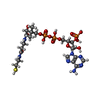


| #88: 化合物 | ChemComp-MG / #89: 化合物 | ChemComp-ZN / #90: 化合物 | ChemComp-COA / | |
|---|
-詳細
| 研究の焦点であるリガンドがあるか | N |
|---|---|
| Has protein modification | N |
-実験情報
-実験
| 実験 | 手法: 電子顕微鏡法 |
|---|---|
| EM実験 | 試料の集合状態: PARTICLE / 3次元再構成法: 単粒子再構成法 |
- 試料調製
試料調製
| 構成要素 |
| ||||||||||||||||||||||||||||
|---|---|---|---|---|---|---|---|---|---|---|---|---|---|---|---|---|---|---|---|---|---|---|---|---|---|---|---|---|---|
| 分子量 |
| ||||||||||||||||||||||||||||
| 由来(天然) |
| ||||||||||||||||||||||||||||
| 由来(組換発現) |
| ||||||||||||||||||||||||||||
| 緩衝液 | pH: 7.7 | ||||||||||||||||||||||||||||
| 試料 | 包埋: NO / シャドウイング: NO / 染色: NO / 凍結: YES | ||||||||||||||||||||||||||||
| 急速凍結 | 凍結剤: ETHANE / 湿度: 100 % |
- 電子顕微鏡撮影
電子顕微鏡撮影
| 実験機器 |  モデル: Titan Krios / 画像提供: FEI Company |
|---|---|
| 顕微鏡 | モデル: TFS KRIOS |
| 電子銃 | 電子線源:  FIELD EMISSION GUN / 加速電圧: 300 kV / 照射モード: FLOOD BEAM FIELD EMISSION GUN / 加速電圧: 300 kV / 照射モード: FLOOD BEAM |
| 電子レンズ | モード: BRIGHT FIELD / 最大 デフォーカス(公称値): 1800 nm / 最小 デフォーカス(公称値): 400 nm |
| 撮影 | 電子線照射量: 40 e/Å2 フィルム・検出器のモデル: GATAN K3 BIOQUANTUM (6k x 4k) |
- 解析
解析
| EMソフトウェア | 名称: PHENIX / バージョン: 1.20.1_4487: / カテゴリ: モデル精密化 | ||||||||||||||||||||||||
|---|---|---|---|---|---|---|---|---|---|---|---|---|---|---|---|---|---|---|---|---|---|---|---|---|---|
| CTF補正 | タイプ: PHASE FLIPPING AND AMPLITUDE CORRECTION | ||||||||||||||||||||||||
| 3次元再構成 | 解像度: 2.82 Å / 解像度の算出法: FSC 0.143 CUT-OFF / 粒子像の数: 23479 / 対称性のタイプ: POINT | ||||||||||||||||||||||||
| 原子モデル構築 | プロトコル: RIGID BODY FIT | ||||||||||||||||||||||||
| 拘束条件 |
|
 ムービー
ムービー コントローラー
コントローラー



 PDBj
PDBj